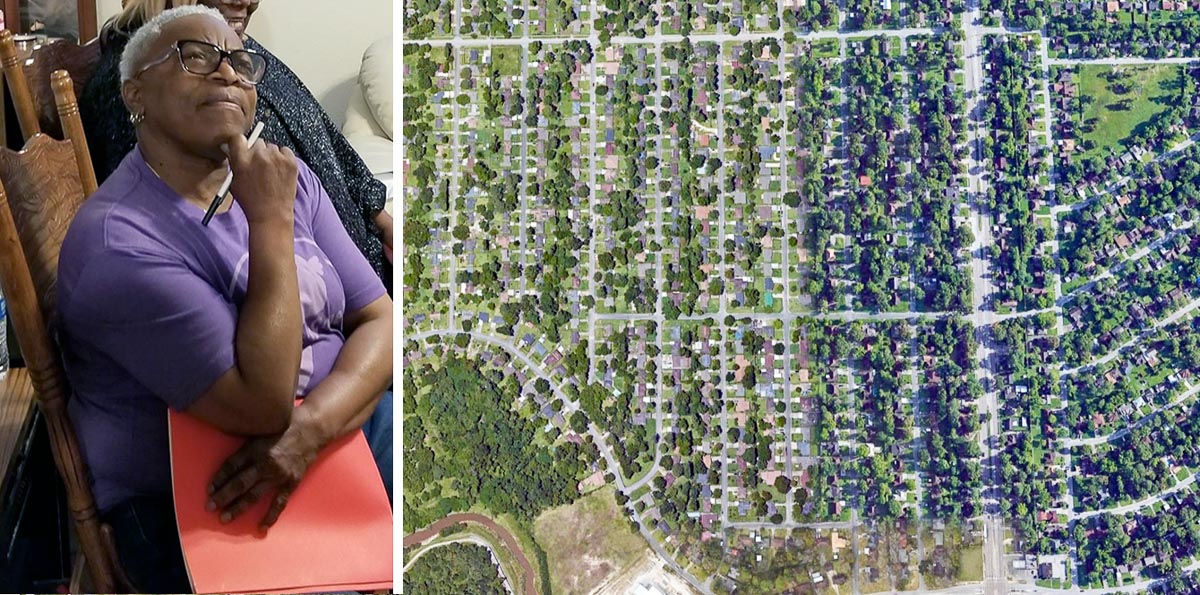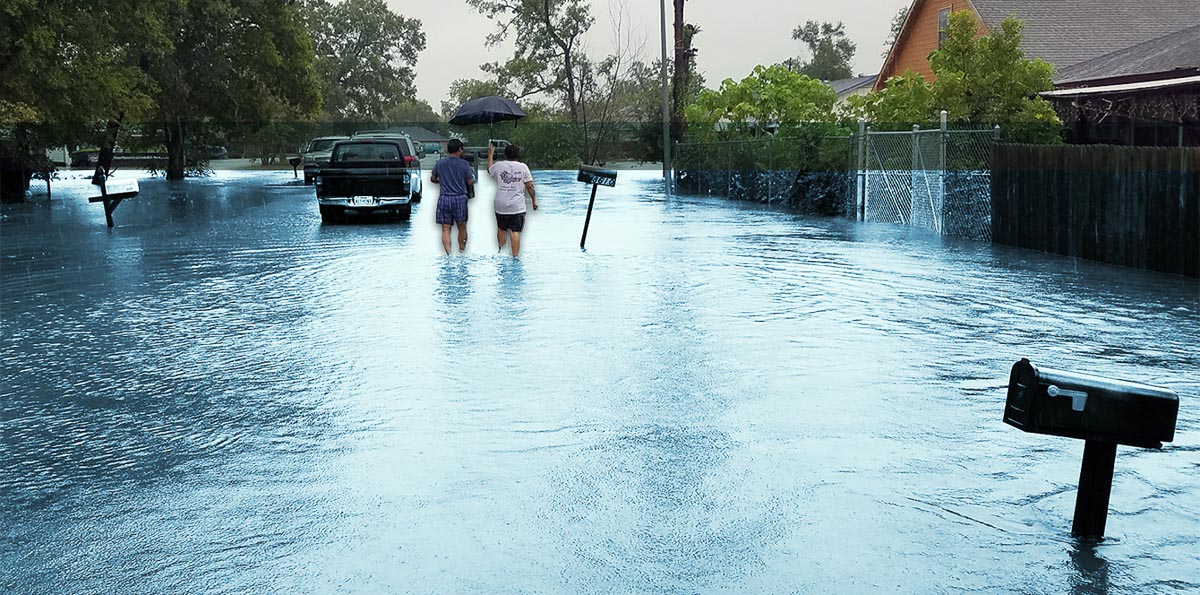Three years ago, Hurricane Harvey walloped the Houston area with record-setting rains and flooding. For many, the devastating storm is drifting into the terrain of history; but thousands of low-income people of color continue working to put their lives back together. While the families that are still recovering are spread across the Bayou City, many are concentrated in Northeast Houston.
Since early February, a team of six Hurricane Harvey Survivors and three West Street Recovery staff members have interviewed 21 Harvey survivors and conducted two focus groups to understand why Northeast Houston has struggled so much more than wealthy neighborhoods like Memorial and Meyerland, which also flooded but now are in pristine condition.
While disaster recovery program evaluation does occur, the perspectives of flood survivors and program participants usually are missing. This exclusion is in part why the disaster recovery apparatus amplifies ongoing injustice. Community-level evaluation, and implementation of the fixes envisioned by survivors themselves are immediate steps that can improve the recovery process.
As a Harvey survivor, I know that community researchers are best positioned to understand the impacts of flooding and an unjust recovery because we lived through the horror and devastation alongside our neighbors, family and friends. We forged relationships of trust; all we had was each other. Because of this bond of trust and familiarity, we can be open and honest with each other. We don’t have to worry about being misunderstood or misrepresented by outsiders.
Although the research project is not concluded, two findings demonstrate the true degree of damage the storm created in Northeast Houston. Of the 21 people interviewed, 19 reported that they had depleted their savings, and 17 reported that their health was negatively impacted by the storm and ongoing recovery.

There simply isn’t enough funding for recovery
One of the reasons many people of color haven’t fully recovered is that government aid and charitable assistance is insufficient and ineffective. In 2001, following the flooding caused by Tropical Storm Allison, I was denied by FEMA. After Harvey, I was convinced it would happen again, but I am an optimist and knew I would fail if I didn’t try.
I really wanted to see if FEMA would ever do the right thing and provide me with the help I needed to repair my home. But they didn't. And the rejection came was faster than it did two decades ago.
I also applied with the Red Cross and Baker Ripley, neither of which have replied in three years. I also applied for aid through the city’s Harvey Homeowner Assistance Program before West Street Recovery — the organization for whom I now work — helped me in repairing my home. Maybe I’m glad I wasn’t in the city program though, because all of my friends who are in it are still waiting for help.
Three years after Harvey, the city has rehabilitated 30 homes, reconstructed 46 homes and the General Land Office has created barrier after barrier that the city and applicants haven’t been able to overcome, Tom McCasland, director of the city’s Housing and Community Development Department, told the Harvey Forgotten Survivors Caucus in a call to discuss a new report on the Harvey recovery situation. Compared to the tens of thousands of homes flooded, this is an abundance of nothing. While many nonprofits have filled gaps left by the governments, nonprofits do not have unlimited funds, and because they are private, they cannot be held democratically accountable.
Understanding the reality of disasters for people of color and low-income residents
Considering the perspectives of poor people and people of color who have lived through natural disasters means we have to discard the understanding that disasters happen at one moment in time and recovery begins immediately.
Instead, we need to be brave enough to acknowledge that marginalized communities face persistent shortages of quality affordable housing, as well as racial violence, poverty and cycles of trauma that storms inflect but do not define. The reality of ongoing and overlapping disaster has been powerfully illustrated throughout the coronavirus pandemic as thousands of Hurricane Harvey survivors still living in homes left damaged and moldy by the storm were ordered to stay at home for a period and then asked to stay home as much as possible. That’s in addition to the racial disparity in COVID-19 infection and death rates.
Current home repair assistance eligibility standards — which exclude people for having houses in heirship, tax debt, not being able to afford flood insurance and deferred maintenance — are a clear example of how viewing disasters as events that take place at one moment amplifies inequality and the racial wealth gap. To address this, government agencies and nonprofits need to affirmatively use disaster recovery to undo our nation’s racist history.
While this sounds grandiose, the researchers who led our study suggest several changes to the disaster response system that would both ameliorate the most unequal outcomes and demonstrate a serious commitment to improving the system overall. Our final report will include more recommendations with further detail, but we can already identify five changes that would make the system more just and equitable:
1. Neighborhoods that are prone to flooding, such as Lakewood or Kashmere Gardens, should have their own neighborhood disaster preparedness and evacuation centers. Survivors want to be included in preparation, and the trauma that begins during evacuation could be reduced dramatically by providing shelter closer to home.
2. After disasters, significant, immediate and universal cash payments should be made to those in locations that have flooded. This would reduce the application burden faced by survivors, who are forced to retell their depressing story again and again, and empower them to manage their own recovery. The 2020 COVID-19 stimulus checks show that with sufficient political will, this is possible.
3. The clerical burden on survivors must be drastically reduced. The application process must be streamlined, and application assistance must be provided. These steps will ensure that those most in need receive help, as opposed to those with the most bureaucratic skill.
4. Community-based groups, which have higher levels of trust and accountability to the people they serve, must receive funding to provide a wider range of services.
5. We need to invest in disaster preparedness. This must include drainage and flood mitigation improvements, repairing homes so that they are more flood resilient and resistant to mold, and developing social networks that can facilitate recovery. This effort must take place at the scale of the neighborhood, not the individual or household.
The entirety of West Street Recovery’s community evaluation of disaster recovery will be out later this year. Please stay in touch and consider supporting our work.
Doris Brown is an advocate and activist who seeks to be a voice for the excluded. She has lived in Scenic woods since 1967 and is a founding member of the Northeast Action Collective and the Harvey Forgotten Survivors Caucus. Brown has worked with West Street Recovery since June 2020.
Ben Hirsch is a cofounder of West Street Recovery and a graduate of the LBJ school of Public Affairs. His interests include the intersection of poverty, race and the environmental and alternative forms of governance.
Further reading on funding for disaster recovery
Two years ago, Kinder Institute researchers released “Rethinking Disaster Recovery and Mitigation Funding in the Wake of Hurricane Harvey,” a report outlining needed improvements in how governments at the local, state and national levels approach the funding of comprehensive disaster preparation, recovery efforts and overall resilience. Suggested improvements to the recovery funding system included:
► Using collaborative entities to leverage the talent of the private and nonprofit sectors during recovery
► Creating regional disaster funding and recovery organizations to supplement federal programs
► Explicitly delineating responsibilities between federal, state and municipal actors
► Introducing a sliding-scale cost-share between the federal government and states instead of guaranteeing funds
► Reforming the National Flood Insurance Program by introducing private competitors or introducing long-term insurance contracts with an explicit obligation to mitigate properties
► Expanding the disaster bond market to provide greater liquidity in disaster funds
You can also check out “Funding Primer: Harvey Relief and Recovery,” which provides insights into the complexities of disaster recovery funding — both how it works and who might be overlooked by it.

